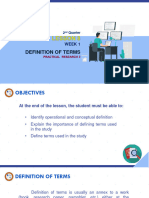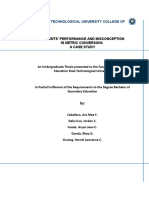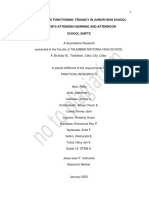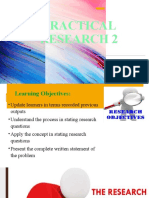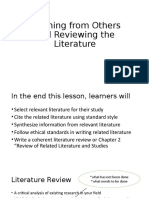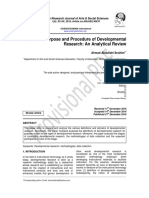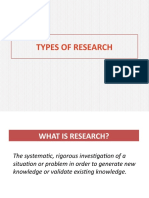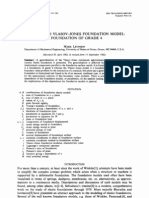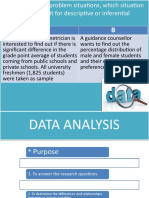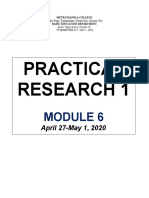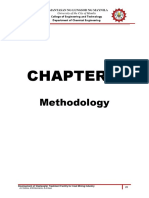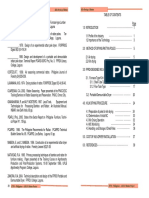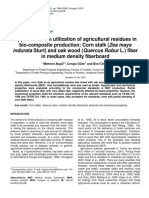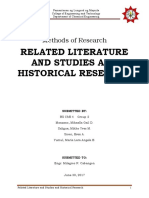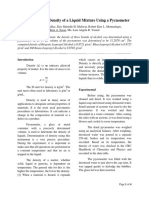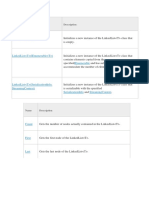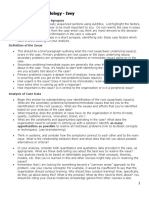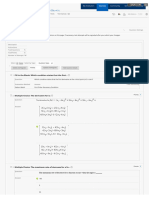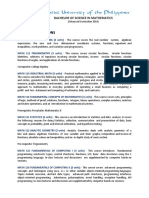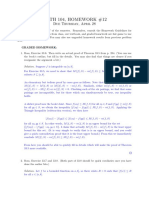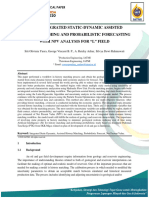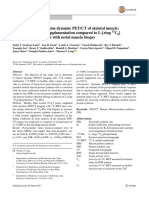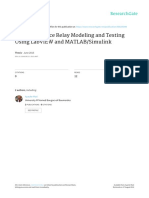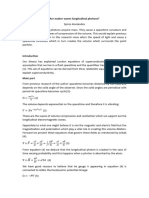How To Write Chapter 3 & 4
Uploaded by
Bren SisonHow To Write Chapter 3 & 4
Uploaded by
Bren SisonPamantasan ng Lungsod ng Maynila
College of Engineering and Technology
Department of Chemical Engineering
Methods of Research
HOW TO WRITE
CHAPTER 3 AND
CHAPTER 4
SUBMITTED BY:
BS ChE 4 Group 2
Manzano, Mikaella Gail D.
Saligue, Mikho Yves M.
Sison, Bren A.
Yumul, Maria Lara Angela B.
SUBMITTED TO:
Engr. Milagros R. Cabangon
August 25, 2017
How to Write Chapter 3 and Chapter 4 1
Pamantasan ng Lungsod ng Maynila
College of Engineering and Technology
Department of Chemical Engineering
RUBRIC FOR PRESENTATION
Saligue, Manzano, Yumul,
Sison,
CRITERIA Mikho Mikaella Maria Lara
Bren A.
Yves M. Gail D. Angela B.
Content 20%
Method
15%
Used
Groupwork 10%
Visual Aid 10%
Audience
10%
Impact
Language
15%
Used
Application 10%
Faculty
10%
Evaluation
TOTAL
How to Write Chapter 3 and Chapter 4 2
Pamantasan ng Lungsod ng Maynila
College of Engineering and Technology
Department of Chemical Engineering
TABLE OF CONTENTS
Objectives ....................................................................................................... 4
How to Write Chapter 3 ................................................................................... 5
Methods of Research ............................................................................. 5
Method of Collecting Data & Development of the Research Instrument .. 5
The Sampling Design ............................................................................. 6
Statistical Treatment of Data ................................................................ 7
The Role of Statistics in Research ................................................ 7
Guidelines in Selection & Application of Statistical Procedures .... 8
How to Write Chapter 4 ................................................................................. 10
Analysis............................................................................................... 10
Group Derived Generalization .............................................................. 12
Preparing Data for Presentation ........................................................... 13
Presentation of Data ............................................................................ 14
Textual Presentation of Data ................................................................ 15
Tabular Presentation of Data ............................................................... 15
Graphical Presentation of Data ............................................................ 22
Purpose of Graphing ............................................................................ 22
Advantages of Graphical Method .......................................................... 22
Limitation of Graphs ............................................................................ 23
Types of Graphs or Charts ................................................................... 24
References .................................................................................................... 35
How to Write Chapter 3 and Chapter 4 3
Pamantasan ng Lungsod ng Maynila
College of Engineering and Technology
Department of Chemical Engineering
OBJECTIVES
General Objective
To determine how to write the research design in Chapter 3 and the
analysis, presentation, and interpretation of data in Chapter 4
Specific Objectives
To identify the topics included in Chapter 3 and Chapter 4 which need to
be given some kind of explanations
To enumerate the role of statistics in research and guidelines in the
selection and application of statistical procedure
To define analysis and enumerate some examples
To identify the three general ways of presenting data and determine the
advantages and disadvantages of each
To define findings, implication, inference, and interpretation
To enumerate the different types of graphs and their uses
How to Write Chapter 3 and Chapter 4 4
Pamantasan ng Lungsod ng Maynila
College of Engineering and Technology
Department of Chemical Engineering
How to Write Chapter 3 - METHODS OF RESEARCH
AND PROCEDURES
Generally, the research design is explained in this chapter. Among those
topics included in the research design which need to be given some kind of
explanations are the following:
Methods of Research Used
Method of Collecting Data and Development of the Research Instrument
Sampling Design
Statistical Treatment
Methods of Research
The method of research used whether historical, descriptive, or
experimental should be explained briefly. The procedural part of the method, its
appropriateness to the study, and some of its advantages should be given
attention and should be well discussed.
Example: Suppose the descriptive method of research was used to the
study entitled “E-waste Management of Cellular Phones, Laptops, Personal
Computers, and Televisions in Selected Government Offices of Metro Manila”.
Briefly the discussion follows:
The descriptive method of research was used in this study. Descriptive
method of research is a fact-finding study with adequate and accurate
interpretation of the findings. It describes what is. It describes with emphasis
what actually exist such as current conditions, practices, situations, or any
phenomena. Since the study was concerned with the assessment of e-waste
management in selected government offices of Metro Manila, the descriptive
method of research was the most appropriate method to use.
Method of Collecting Data and Development of the Research
Instrument
The method of collecting data and the development of the instrument for
gathering data must also be explained.
How to Write Chapter 3 and Chapter 4 5
Pamantasan ng Lungsod ng Maynila
College of Engineering and Technology
Department of Chemical Engineering
Example: The method of collecting data used was the normative survey
and standardized interview. Normative survey is concerned with looking into the
commonality of some elements. It is used to collect demographic data about local
government officials and employee’s behavior, practices, intentions, beliefs,
attitudes, opinions, judgments, interests, and perceptions about the programs
and practices of proper handling, disposal, and recycling of e-wastes
implemented in their offices. Moreover, standardized interview is also used to
gather valid and adequate information.
The instrument used to collect data was the questionnaire. This was used
because it gathers data faster than any other method. Besides, the respondents
were government officials and employees and so they are literate. They could
read and answer the questionnaire with ease. A set of interview questions is also
used for choice persons to yield a more complete and valid information.
Development of the instrument. After reading and studying samples of
questionnaire from related studies, the researchers prepared their own
questionnaire and interview questions. They also consulted some knowledgeable
people about how to prepare one. The researchers saw to it that there were
enough items to collect data to cover all aspects of the problem and to answer
all the specific questions under the statement of the problem.
The Sampling Design
Before the collection of data starts in any research project, the proportion
of the population to be used must have been determined already and the
computation of the sample must have been finished. So, that the researcher has
to do here is two write about the complete procedure he used in determining his
sample. Among the things that he should explain are:
a. The size of the population;
b. The study population
c. The margin of error and the proportion of the study population used;
d. The type or technique of sampling used whether pure random sampling,
systematic random sampling, stratified sampling, cluster sampling or a
combination of two or more techniques;
e. The actual computation of the sample; and
f. The sample.
How to Write Chapter 3 and Chapter 4 6
Pamantasan ng Lungsod ng Maynila
College of Engineering and Technology
Department of Chemical Engineering
The researcher must explain very clearly how he selected his sample. He
must be able to show that his sample is representative of the population by
showing that he used the appropriate technique of sampling. This is very
important because if it appears that his sample is not representative, his findings
and conclusions will be faulty and hence, not valid and reliable.
Example: This descriptive study will be conducted among selected
government offices in Metro Manila namely, Department of Labor and
Employment (DOLE), Manila City Hall, National Bureau of Investigation (NBI),
Commission on Elections (COMELEC), and Department of Justice (DOJ).
Information such as policies and programs and inventory of e-waste generation
will be gathered from the duly-recognized offices which concerns the waste’s
disposal. Other information may be obtained from informal interviews and the
researchers’ personal observations.
Statistical Treatment of Data
The last part of this chapter usually describes the statistical treatment of
data. The kind of statistical treatment depends upon the nature of the problem,
especially the specific problems, and the nature of the data gathered. The explicit
hypotheses particularly determine the kind of statistics to be used.
The Role of Statistics in Research
With the advent of the computer age, statistics is now playing a vital role
in research. This is true especially in science and technological research. Some
of the role of statistics in research are the following:
1. Statistical methods help the researcher in making his research design,
particularly in experimental research. Statistical methods are always
involved in planning a research project because in some way statistics
directs the researcher how to gather his data.
2. Statistical techniques help the researcher in determining the validity and
reliability of his research instruments. Data gathered with instruments
that are not valid and reliable are almost useless and so the researcher
must have to be sure that his instruments are valid and reliable. Statistics
help him in doing this.
How to Write Chapter 3 and Chapter 4 7
Pamantasan ng Lungsod ng Maynila
College of Engineering and Technology
Department of Chemical Engineering
3. Statistical manipulations organize raw data systematically to make the
latter appropriate for study. Unorganized data cannot be studied. No
inferences nor deductions can be made from unorganized data. Statistics
organize data systematically by ordered arrangement, ranking, score
distribution, class frequency distribution or cumulative frequencies. These
make the data appropriate for study.
4. Statistics are used to test the hypotheses. Statistics help the researcher to
determine whether his hypotheses are to be accepted or to be rejected.
5. Statistical treatments give meaning and interpretation to data. For
instance, if the standard deviation of the class frequency of a group is
small, we know that the group is more or less homogeneous but if it is
large, the group is more or less heterogeneous.
6. Statistical procedures are indispensable in determining the levels of
significance of vital statistical measures. These statistical measures are
the bases for making inferences, interpretations, conclusions or
generalizations.
Guidelines in the Selection and Application of Statistical Procedures
The researcher must have at least a rudimentary knowledge of statistics
so that he will be able to select and apply the appropriate statistical methods for
his data. Some suggestions for the selection and application of statistical
technique follows:
1. First of all, the data should be organized using any or all of the following
depending upon what is desired to be known or what is to be computed:
talligram (tabulation table), ordered arrangement of scores, score
distribution, class (grouped) frequency distribution, or scattergram.
2. When certain proportions of the population based on certain variables,
such as age, height, income, etc. are desired to be known, frequency
counts with their frequency percents may be used. For further analysis,
cumulative frequencies (up and down) with their respective cumulative
frequency percents (up and down) may also be utilized.
3. When the typical, normal, or average is desired to be known, the measures
of central tendency such as the median, the mean or the mode may be
computed and used.
4. When the variables being studied are abstract or continuous such that
they cannot be counted individually such as adequacy, efficiency,
How to Write Chapter 3 and Chapter 4 8
Pamantasan ng Lungsod ng Maynila
College of Engineering and Technology
Department of Chemical Engineering
excellence, extent, seriousness (of problems), and the like, the weighted
mean may be computed and used if the average is desired to be known.
The variable is divided into categories of descending degree of quality and
then each degree of quality is given aa weight.
5. When the variability of the population is desired to be known, the measure
of variability such as the range, quartile deviation, average deviation or the
standard deviation may be computed and used. Then the measure of
variability or dispersion is small, the group is more or less homogeneous
but when the measure of variability is large, the group is more or less
heterogeneous.
6. When the relative placements of scores or positions are desired to be
known, ranking, quartile or percentile rank may be computed and used.
These measures indicate the relative positions of scores in an ordered
arrangement of the scores.
7. When the significance of the trend of reactions or opinion of persons as a
group toward a certain issue, situation, value or thing is desired to be
known but in which there is neutral position, the chi-square or equal
probability, single group, is computed and interpreted.
8. When the significance of the difference between the reactions, or opinions
of two distinct groups in which there is a neutral position is desired to be
known, the chi-square or equal probability, two- group, is computed and
used.
9. To determine how one variable varies with another, the coefficient of
correlation is computed.
10. If the significance of the difference between the perceptions of two
groups about a certain situation is to be studied, the computation of the
difference between means is to be made.
11. To determine the relative effectiveness of the different wats of doing
things to which different randomized, analysis of variance is appropriate
to use.
12. To determine the effects of some variables upon a single variable to
which they are related, partial and multiple correlations are suggested to
be used.
13. To determine the association between two independent variables,
the chi-square of independence or chi-square of multiplication may be
used.
How to Write Chapter 3 and Chapter 4 9
Pamantasan ng Lungsod ng Maynila
College of Engineering and Technology
Department of Chemical Engineering
How to Write Chapter 4 – ANALYSIS, PRESENTATION,
AND INTERPRETATION OF DATA
Analysis
Analysis is the process of breaking up the study into its constituent parts
of categories according to the specific questions under the statement of the
problem. This is to bring out into focus the essential features of the study.
Example
1. The amount of use of each electronic device.
2. The degree of awareness of respondents about electronic wastes.
3. The methods applied by respondents in disposing e-wastes.
Each constituent part may still be divided into its essential categories.
Example
For the amount of use of each electronic device
For cellular phones
a. From the Department of Labor and Employment
b. From Manila City Hall
c. From National Bureau of Investigation
d. From Commission on Elections
e. From Department of Justice
And likewise for the other categories.
For the awareness of respondents
a. Aware (100-70%)
b. Partially Aware (30-69%)
c. Poorly Informed (0-29%)
For the methods of e-waste disposal
a. Collection Centre
b. Pit for Burning
c. Landfill/Dumpsite
How to Write Chapter 3 and Chapter 4 10
Pamantasan ng Lungsod ng Maynila
College of Engineering and Technology
Department of Chemical Engineering
The data are then grouped under the categories or parts to which the
belong.
Classification of Data
Classification is the grouping together of data with similar characteristics.
The bases of classification are the following:
Qualitative
Those having the same quality or are of the same kind are grouped
together.
Quantitative
Data are grouped according to their quantity.
Geographical
Data are grouped according to their location.
Chronological
Data are classified according to the order of their occurrence.
Cross classification
This is further classifying a group of data into subclasses. This is breaking
up or dividing a big class into smaller classes.
Arrangement of data or classes of data
Qualitative
Data may be arranged alphabetically, or from the biggest to the
smallest class as from phylum to specie in classifying animals, or from the
most important to the least important.
Quantitative
This is arranging data according to their numerical magnitudes,
from the greatest to the smallest number or vice versa.
Geographical
Data may be arranged according to their geographical location or
according to direction.
How to Write Chapter 3 and Chapter 4 11
Pamantasan ng Lungsod ng Maynila
College of Engineering and Technology
Department of Chemical Engineering
Classification, cross-classification and arrangement of data are done for
purposes of organizing the thesis report and in presenting them in a tabular
form. Data are properly and logically classified and arranged so that their
relationships are readily seen.
Group Derived Generalizations
One of the main purposes of analyzing research data is to form inferences,
interpretations conclusions, and/or generalizations from the collected data. The
researcher should be guided by the following discussions about group-derived
generalizations.
The use of the survey as a method of collecting data for research implies
the study of groups. From the findings are formulated conclusions in the form of
generalizations that pertain to the particular group studied. These conclusions
are called group-derived generalizations designed to represent characteristics of
groups and are to be applied to groups rather than to individual cases one at a
time.
Generally, only proportional predictions can be made.
One type of generalization is that which is expressed in terms of
proportion of the cases in a group, often in the form of probability. When
this type is used, we do not have enough information about individual
cases to make predictions for them, but we can predict for a group of future
observations.
The average can be made to represent the whole group.
A second type of group-derived generalization results from using the
average as a representation of the group of cases and offering it as a typical
result. This is ignoring the variation existing in the group but the average
represents the whole group. Generally, the mean and the median are used
to derive the averages, but other measures such as variation, correlation
ang regression are also structurally considered as averages.
Full-frequency distribution reveals characteristics of a group.
A third is the full-frequency distribution. Frequency distribution
carry the implication of probability.
A group itself generates new qualities, characteristics, properties or
aspects not present in individual cases.
How to Write Chapter 3 and Chapter 4 12
Pamantasan ng Lungsod ng Maynila
College of Engineering and Technology
Department of Chemical Engineering
Group properties that exist only in groups are order, arrangement,
cooperation, opposition, organization, specialization, leadership, teaching,
and morale.
Two additional categories of generalization may be added:
A generalization can also be made about an individual case
A special condition may be singularly available to an individual. A
generalization may be made from this.
In certain cases, prediction on individual cases can be made
In correlation and regression, one variable can be predicted from
another.
Preparing Data for Presentation
Before presenting data in accepted forms, especially in presenting them in
statistical tables, they have to be tallied first in a tabulation diagram which may
be called talligram, a tally and a diagram together. The individual responses to
a questionnaire or interview schedule have to be tallied one by one.
How to construct a talligram
1. Determine the classes and their respective subclasses along with their
respective numbers.
2. Make rows for the classes by drawing horizontal lines with appropriate
spaces between the lines and the number of the rows should be two more
than the number of classes.
3. Make columns for the subclasses by drawing vertical lines whit
appropriate spaces between the lines and the number of columns should
be two more than the number of subclasses.
How to tally data
The individual responses to a questionnaire or interview schedule must be
tallied one by one.
How to Write Chapter 3 and Chapter 4 13
Pamantasan ng Lungsod ng Maynila
College of Engineering and Technology
Department of Chemical Engineering
Presentation of Data
Presentation is the process of organizing data into logical, sequential, and
meaningful categories and classifications to make them amenable to study and
interpretation. Analysis and presentation put data into proper order and in
categories reducing them into forms that are intelligible and interpretable so that
the relationships between the research specific questions and their intended
answers can be established. There are three ways of presenting data: textual,
tabular and graphical.
How to Write Chapter 3 and Chapter 4 14
Pamantasan ng Lungsod ng Maynila
College of Engineering and Technology
Department of Chemical Engineering
TEXTUAL PRESENTATION OF DATA
Textual presentation uses statements with numerals or numbers to
describe data. The main aims of textual presentation are to focus attention to
some important data and to supplement tabular presentation.
The disadvantage, especially if it is too long, is that it is boring to read and
the reader may not even be able to grasp the quantitative relationships of the
data presented. The reader may even skip some statements.
TABULAR PRESENTATION OF DATA
When presenting ideas that include references to data, it can be helpful to
make the point using a table or graph. Text alone should not be used to convey
more than three or four numbers. Sets of numerical results should usually be
presented as tables or pictures rather than included in the text. Well-presented
tables and graphs can concisely summarize information which would be difficult
to describe in words alone.
On the other hand, poorly presented tables and graphs can be confusing
or irrelevant. While they can be powerful methods, they also have the potential
to ruin a presentation if they convey the wrong message or they confuse the
audience. Appropriate use of tables and graphs is one way to enhance the
message you are delivering. It is crucial to remember that when using a table or
graph the associated text should describe what the data reveal about the topic;
you should not need to describe the information again in words.
Tables and graphs should, ideally, be self-explanatory. The reader should
be able to understand them without detailed reference to the text, on the grounds
that users may well pick things up from the tables or graphs without reading the
whole text. The title should be informative, and rows and columns of tables or
axes of graphs should be clearly labeled.
A statistical table or simply table is defined as a systematic arrangement
of related data in which classes of numerical facts or data are given each a row
and their subclasses are given each a column in order to present the
How to Write Chapter 3 and Chapter 4 15
Pamantasan ng Lungsod ng Maynila
College of Engineering and Technology
Department of Chemical Engineering
relationships of the sets or numerical facts or data in a definite, compact, and
understandable form or forms. (Calderon, et al, p.210)
The purpose of a table is to facilitate the study and interpretation, the
making of inferences and implications of the relationships of statistical data.
Table construction for data presentation is a part of analysis because the data
are separated and grouped according to class or category.
Advantages of tabular over textual presentation of data. (Calderon, et al,
p.210) The advantages of the tabular over the textual presentation of data are:
1. Statistical tables are concise, and because data are systematically grouped
and arranged, explanatory matter is minimal.
2. Data are more easily read, understood, and compared because of their
systematic and logical arrangement into rows and columns. The reader
can understand and interpret a great bulk of data rapidly because he can
see significant relationships of data at once.
3. Tables give the whole information even without combining numerals with
textual matter. This is so because tables are so constructed that the ideas
they convey can be understood even without reading their textual
presentation.
How to Write Chapter 3 and Chapter 4 16
Pamantasan ng Lungsod ng Maynila
College of Engineering and Technology
Department of Chemical Engineering
The major functional parts of a statistical table. (Bacani, et al, p. 55)
Table Number
Title
(Headnote)
Stub Head Master Caption
Column Column Column Column
Caption Caption Caption Caption
Row Label Entry Entry Entry Entry
Total:
Footnote:
Source note:
The above illustration of a table is only a simple one. There are tables that
are very complicated. For instance, the column caption may further be
subdivided into sub-column captions which in-turn may still be subdivided. This
happens when the subject matter of the table is classified, then the first
classifications are further sub-classified, and so on.
1. Table Number. Each table should have a number, preferably in Arabic, for
reference purposes. This is because only the table numbers are cited. The
number is written above the title of the table. Tables are numbered
consecutively throughout the thesis report. If there is only one table the
number is unnecessary.
2. Title. The title should tell about the following:
a. The subject matter that said table deals with;
How to Write Chapter 3 and Chapter 4 17
Pamantasan ng Lungsod ng Maynila
College of Engineering and Technology
Department of Chemical Engineering
b. Where such subject matter is situated, or to what entity or persons
it belongs, or from whom the data about such matter were gathered;
c. When data about such subject matter were gathered or the time
period when such data were existent; and
d. Sometimes how the data about such subject matter are classified.
Usually, however, only the first two elements are mentioned in the title,
and occasionally, only the subject matter. Only the beginning letters of the
important words in the title are capitalized. If the title contains more than
one line, it should be written like an inverted pyramid.
3. Headnote or Prefatory Note. This is written below the title and it is usually
enclosed in parentheses. It explains some things in the table that are not
clear.
Suppose a table entitled “People with HIV Aids” is to be constructed and
the entries in the table are in rounded millions of people. Instead of
entering 37 million of people, the entry is only 37. The headnote that
should be written below the title should be “Millions of People”.
4. Stub. The stub contains the stub head and the row labels. The stub head
tells what the stub contains, the row labels. Each row label describes the
data contained in that row.
5. Box Head. The box head contains the master caption, the column captions,
and the column subcaptions. The master caption describes the column
captions and the column captions in turn describe the subcolumn
captions.
6. Main body, field, or text. The main body, field, or text of the table contains
all the quantitative and/or proportional information presented in the table
in rows and in columns.
7. Footnote. The footnote which appears immediately below the bottom line
of the table explains, qualifies, or clarifies some items in the table which
are not readily understandable or are missing. Proper symbols are used to
indicate the items that are clarified or explained. The footnote is not
How to Write Chapter 3 and Chapter 4 18
Pamantasan ng Lungsod ng Maynila
College of Engineering and Technology
Department of Chemical Engineering
necessary if everything in the table is clear and there is nothing to clarify
or explain.
8. Source note. The source note which is generally written below the footnote
indicates the origin or source of the data presented in the table. The source
note is not necessary if the sources of the data are the respondents to a
questionnaire or interview schedule. ‘The purpose of placing the source
note are:
a. To give credit or recognition to the author of the table or the sources or
h sources of the data;
b. To allow the users to secure additional data from the same source;
c. To provide the user for determining the accuracy and reliability of the
information provided by the table, and;
d. To protect the maker of the table against any charge of inaccuracy and
unreliability.
Rulings and spacing in tables. (Calderon, et al, p.210) Ruling is done in a table
to emphasize or make clear relationships. There are no fixed standard rules to
follow in ruling and spacing tables. Emphasis and clarity are the determining
factors. However, the following guidelines are generally followed in the
construction of tables for a thesis report:
1. The table number is not separated by line from the title. It is written two
spaces above the title.
2. The title is separated from the rest of the table by a double line placed two
spaces below the lowest line of the title.
3. The stub, master caption, captions, subcaptions, and totals are separated
from one another by vertical and horizontal lines.
4. The rows and columns are not separated by lines. Major groups, however,
are separated by single lines. For purposes of clarity, rows are separated
by a double space and the columns are separated by as wide a space as
possible.
How to Write Chapter 3 and Chapter 4 19
Pamantasan ng Lungsod ng Maynila
College of Engineering and Technology
Department of Chemical Engineering
5. Both ends of the table are unruled
6. There is always a line, either single or double, at the bottom of the table.
Unity in a table. There should always be unity in a table. To achieve this,
presenting too many ideas in a single table should be avoided. One subject
matter is enough, one that can be divided into categories which in turn
can be divided into common classifications.
Textual Presentation of Tabular Data
Generally, there should be a textual presentation of a table which precedes
the table or the table may be placed within the textual presentation. The table
and its textual presentation should be placed as near as possible to each other.
Textual presentation is mixing words with numbers in statements.
There are two ways of making a textual presentation of a table;
1. All the items in the table are textually presented. This manner enables the
reader to comprehend the totality of the data even without consulting the
table. This is alright if the data are not so many. However, if the data are
so numerous, reading becomes boring and the reader may even skip some
of the items.
2. Only the highlights or important parts of the data are textually presented.
The basic principles that should be remembered in the textual
presentation of a table are:
1. The textual presentation of a table should be as complete as possible so that
ideas conveyed in the table are understood even without referring to the table
itself.
2. Textual presentation is generally followed by interpretation, inference, or
implication. This is done after the data from the table have been textually
presented.
How to Write Chapter 3 and Chapter 4 20
Pamantasan ng Lungsod ng Maynila
College of Engineering and Technology
Department of Chemical Engineering
Implication, inference, interpretation. These three terms are synonymous if
not exactly the same in meaning. They are used interchangeably. Each is a
statement or statements of the possible meaning, revealed by the findings
plus a veiled suggestion to continue the situation if it is good or to adopt some
remedial measures to eradicate or minimize its bad effects. Those who are to
be benefitted and those who are going to suffer the bad effects should also be
mentioned.
Implication, inference, or interpretation has at least four elements, namely,
condition, cause, effect, and continuance of remedial measure.
a. Statement of the condition or situation. The condition or situation is
stated based upon the findings, whether satisfactory or unsatisfactory.
b. Probable cause of the condition. Usually, also very condition has a
cause but, there must also be a logical and valid relationship between
the condition and its cause.
c. Probable effects of the condition. Usually, also every condition has an
effect, either bad or good. However, there must also be a logical and
valid relationship between the condition and its effect and this must be
clearly given.
d. A veiled suggestion for continuance or remedial measure, if the possible
effect is bad. If the effect of the condition is good, then there must be a
hint for the continuance of the existence of the condition. However, if
the effect is deleterious there must be some suggestions for the
adoption of measures aimed at minimizing the harmful effects.
3. Findings in the present study should be compared with the findings of other
studies as presented in the related literature and studies. This enables the
researcher to make some generalizations if there are enough data to support
such generalizations.
Findings are the original data, quantitative or otherwise, derived or taken
from the original sources and which are results of questionnaires, interviews,
experiments, tests, observations, and other data gathering instruments. Data
presented in tables and their textual presentations are examples of findings.
Findings do not directly answer the specific questions asked at the beginning
of the investigation or the explicit hypotheses but the findings provide the
bases for making the answers. Hence, the main functions of the findings are
to provide bases for making the conclusions.
How to Write Chapter 3 and Chapter 4 21
Pamantasan ng Lungsod ng Maynila
College of Engineering and Technology
Department of Chemical Engineering
GRAPHICAL PRESENTATION OF DATA
DEFINITON OF GRAPH
A graph a diagram showing the relation between variable quantities, typically of
two variables, each measured along one of a pair of axes at right angles. It is a chart
representing the quantitative variations or changes of a variable itself, or quantitative
changes of a variable in comparison with those of another variable or variables in
pictorial or diagrammatic form.
PURPOSE OF GRAPHING
The purpose of graphing is to present the variations and relationships of the data
gathered in your research in a visually appealing, and logical manner.
ADVANTAGES AND LIMITATIONS OF THE GRAPHIC METHOD
A. Advantages of the Graphic Method
1. It attracts attention and therefore is less likely to be overlooked.
Readers may skip tables but pause to look at charts.
2. The use of colours and pictorial diagrams make a list of figures in
presentations and reports more meaningful.
3. It gives a comprehensive view of quantitative data. The wandering
line exerts a more powerful effect in the reader’s mind than
tabulated data. It shows what is happening and what is likely to take
place.
4. Graphs enable the busy executive of a business concern to grasp the
essential facts quickly and without much trouble. Any relation not
seen from the figures themselves is easily discovered from the graph.
Illustrations, including attractive charts and graphs, are now
considered as indispensable accompaniment to good presentations.
How to Write Chapter 3 and Chapter 4 22
Pamantasan ng Lungsod ng Maynila
College of Engineering and Technology
Department of Chemical Engineering
5. Their general usefulness lies in the simplicity they add to the
presentation of numerical data.
B. Limitations of the Graphic Method
1. Graphs do not show as much information at a time as do tables.
2. Graphs do not show data as accurately as the tables do.
3. Charts require more skill, more time, and more expense to prepare
than tables.
4. Graphs cannot be quoted in the same way as tabulated data.
5. Graphs can be made only after the data have been tabulated.
ESSENTIALS OF A GRAPH
The essential parts of a graph are the following:
E-waste Disposal of Government Offices
100%
90% 13.79
44.83
80% 41.38
70%
16.67
60%
Landfill
50%
25 53.33 Pit for Burning
40%
Collection Center
30%
33.33
20%
33.33
10% 33.33
0%
Office 1 Office 2 Office 3
Footnotes:
a. The number of respondents, 59, was the base used in the
computation of the percentages.
How to Write Chapter 3 and Chapter 4 23
Pamantasan ng Lungsod ng Maynila
College of Engineering and Technology
Department of Chemical Engineering
Source: E-Waste Management Survey, 2017
Figure 1. E-Waste Disposal of Three Government Offices
1. Number. Charts or graphs are also numbered for reference purposes. The
general practice is to write the numbers as Figure1, Figure 2, Figure 3, etc.
at the bottom of the graph.
2. Title. The title is usually written above the graph.
3. Scale. This indicates the length or height unit that represents a certain
amount of the variable which is the subject of the graph. The scale enables
the readers to interpret the significance of a number of length or height
units.
4. Classification and arrangement. The principles of classification and
arrangement are the same in graphs as in tables.
5. Symmetry of the Graph. The whole chart or graph should be about
square, otherwise the length should be a little greater than the height. The
margins on the left and right of the graph should be equal.
6. Footnote. This should be placed below the graph and aligned with the left
side of the graph.
7. Source. This should be written just below the chart at the lower left, below
the footnote but above the graph number.
TYPES OF GRAPHS
Graphs may be classified as follows:
1. Bar Graphs. Also known as a Pareto Diagram, a bar graph can be
horizontal or vertical. Each axis is labelled with either a categorical or a
numerical variable. The bars’ heights are scaled according to their values
and the bars can be compared to each other. Bar graphs can be drawn in
a 3-dimensional way and compiled for data comparison about the same
How to Write Chapter 3 and Chapter 4 24
Pamantasan ng Lungsod ng Maynila
College of Engineering and Technology
Department of Chemical Engineering
thing or location. So that more important categories are emphasized, bars
in a bar graphs are arranged in order of frequency.
a. Single Vertical Bar Graph. This portrays the magnitudes of the
categories into which data have been classified. Vertical bars are usually
used to depict time series data.
Figure 2. Vertical Bar Graph
b. Single Horizontal Bar Graph. This graph compares the magnitudes of
the categories into which data have been classified. Horizontal graphs
are usually used to compare magn itudes of categories.
How to Write Chapter 3 and Chapter 4 25
Pamantasan ng Lungsod ng Maynila
College of Engineering and Technology
Department of Chemical Engineering
Figure 3. Horizontal Bar Graph
c. Grouped or Composite Bar Graph. This is used in two or more
categories of a variable during a specified period of time when the
subgroups of the categories have common attributes.
Figure 4. Grouped Bar Graph
How to Write Chapter 3 and Chapter 4 26
Pamantasan ng Lungsod ng Maynila
College of Engineering and Technology
Department of Chemical Engineering
d. Duo-directional or Bilateral Bar Graph. This graph is ised to present
data in the form positive and negative numbers.
Figure 5. Bilateral Bar Graph
e. Subdivided or Component Bar Graph. This is used to show the
variations or changes of the component parts of a whole and the whole
itself.
How to Write Chapter 3 and Chapter 4 27
Pamantasan ng Lungsod ng Maynila
College of Engineering and Technology
Department of Chemical Engineering
Figure 6. Subdivided Bar Graph
f. Histogram. A histogram is composed of bars placed side by side whose
heights indicate the magnitudes of their respective classes or categories.
It is used with grouped or class frequency distributions.
Figure 7. Histogram
How to Write Chapter 3 and Chapter 4 28
Pamantasan ng Lungsod ng Maynila
College of Engineering and Technology
Department of Chemical Engineering
2. Linear Graphs. Linear graphs are good devices to show variations of values
over successive periods of time. Changes in the data are indicated by the
linear curves. They organize and present data in a clear manner and show
relationships between the data. They are used for personal, educational,
and professional reasons. Particularly popular in the fields of science and
statistics, they can also forecast the results of data that is not yet gathered.
a. Time Series or Chronological Line Chart. Time series charts depict the
variations of a variable over a period of time. Generally, the x-axis
represents the periods of time and y-axis represents quantitative values
of the variable. The intersections are marked and then joined
successively by straight or curved lines.
Figure 8. Chronological Line Chart
b. Composite Line Chart. These are used when comparisons are made
between or among categories of the same variables or variations of two
or more variables over periods of time.
How to Write Chapter 3 and Chapter 4 29
Pamantasan ng Lungsod ng Maynila
College of Engineering and Technology
Department of Chemical Engineering
Figure 9. Composite Line Chart
c. Frequency Polygon. This is used to graph class or grouped frequency
distributions. The x-axis represents the classes and the y-axis represents
the frequencies of the classes.
Figure 10. Frequency Polygon
How to Write Chapter 3 and Chapter 4 30
Pamantasan ng Lungsod ng Maynila
College of Engineering and Technology
Department of Chemical Engineering
d. Ogive. An ogive graph plots cumulative frequency on the y-axis
and class boundaries along the x-axis. It’s very similar to a histogram,
only instead of rectangles, an ogive has a single point marking where the
top right of the rectangle would be. It is usually easier to create this kind
of graph from a frequency table.
Figure 11. Ogive
e. Band Chart. A band chart is a form of line graph of the time series
variety. It shows the proportional variations of the component parts of a
whole over a period of time. The percent equivalents of the components
are the ones plotted but absolute values may be used, though rarely.
3. Hundred-percent Graphs or Charts. One hundred percent graphs or
charts show the comparison of the proportional sizes of the component parts
that make up the whole, the whole being made equivalent to 100 percent. It
is the percent equivalent of the component parts that are portrayed in the
graph.
How to Write Chapter 3 and Chapter 4 31
Pamantasan ng Lungsod ng Maynila
College of Engineering and Technology
Department of Chemical Engineering
a. Rectangular Bar Graph. The bar is subdivided into segments whose
number is equal to the number of component parts. The size of each
segment is proportional to the percent of the component part it
represents. The segments are arranged according to size with the largest
segment at the bottom. Each segment is labelled by the value and percent
it represents, the percent inside and the value outside.
b. Pie Graph. The circle graph has the same principles and functions as
the rectangular chart. It is also equated to 100% and because the circle
360 degrees, 1% is equated to 3.6 degrees.
Figure 12.Pie Graph
4. Pictograms. The pictogram or pictograph is used to portray data by means
of pictures or symbols. Since the pictogram cannot portray data accurately,
its only purpose is to make the comparison of magnitudes more vivid and
clear.
How to Write Chapter 3 and Chapter 4 32
Pamantasan ng Lungsod ng Maynila
College of Engineering and Technology
Department of Chemical Engineering
Figure 13.Pictogram
HOW TO CREATE A GRAPH FROM TABULAR DATA
1. Make sure that the tabular data translated from textual data is correct,
accurate, and follows the guidelines of tabular data presentation.
2. Determine the type of graph to be used (bar, linear, hundred percent,
or pictogram), then determine the subtype of the graph to be used.
3. Identify all the components, as well as what components should be in
the x-axis and the y-axis.
4. Plot the tabular data gathered from your research into the graph.
5. Make sure that the scale indicated in your graph is clear and can be
easily understood by the reader.
6. Check if the margin on the left and right side of the graph are equal.
7. Write the legend so that it can be easily seen by the reader.
8. Put the footnotes just below the graph, align it to the left side of your
graph.
9. Put the source below the footnote and cite your sources correctly.
10. Finally, put the number of your graph at the bottom part.
How to Write Chapter 3 and Chapter 4 33
Pamantasan ng Lungsod ng Maynila
College of Engineering and Technology
Department of Chemical Engineering
IMPLICATIONS OF THE FINDINGS
It is the general practice of thesis writers to discuss the summary of the
implications of their findings at the end of chapter 4 or elsewhere in the thesis.
From observations, it appears that as far as research reporting is concerned,
an implication consists of at least five elements, namely:
1. The existence of a condition. This condition is a finding discovered in the
research. The condition may be favourable or unfavourable. If it is
favourable, it is a strength of the subject studied. If it is unfavourable, it is
a weakness of the subject.
2. The probable cause of the condition. If there is a condition there must
be a cause and there must be a logical relationship between the condition
and the cause, otherwise the cause may not be a valid one.
3. The probable effect of the condition. Most likely, there is also a probable
effect of the condition and there must be a logical relationship between the
condition and its probable effect.
4. The measure to remedy the unsatisfactory condition or to continue to
strengthen the favourable one. It is a natural reaction to institute a
measure to remedy an unfavourable situation. However if the condition is
found to be a favourable one, it is also a natural reaction to continue it in
operation and to even further strengthen it.
5. The entity or area involved or affected. The area directly affected by the
unfavourable or favourable conditions discovered in the study should be
cited more specifically.
How to Write Chapter 3 and Chapter 4 34
Pamantasan ng Lungsod ng Maynila
College of Engineering and Technology
Department of Chemical Engineering
REFERENCES
(March 2000). Informative Presentation of Tables, Graphs, and Statistics. U.K.:
The University of Reading Statistical Services Centre.
(March 2001). Approaches to the Analysis of Survey Data. U. K.: The University
of Reading and Statistical Services Centre.
Ardales, V. B. (1992). Basic Concepts and Methods in Research.
Ariola, D. M. (2006). Principles and Methods of Research.
Calderon, J. F. (1993). Methods of Research and Thesis Writing. Mandaluyong
City: National Book Store, Inc.
Presenting Numerical Data. (2012). Learning Development, University of
Leicester .
How to Write Chapter 3 and Chapter 4 35
You might also like
- Statistics in Educational Research: AbstractNo ratings yetStatistics in Educational Research: Abstract4 pages
- Rizal Technological University College of EducationNo ratings yetRizal Technological University College of Education77 pages
- Group 16 Chapter 17 How To Write Chapter 5 Conclusion. and RecommendationsNo ratings yetGroup 16 Chapter 17 How To Write Chapter 5 Conclusion. and Recommendations10 pages
- Strengths & Weaknesses of Quantitative ResearchNo ratings yetStrengths & Weaknesses of Quantitative Research1 page
- Definition Purpose and Procedure of Developmental Research: An Analytical ReviewNo ratings yetDefinition Purpose and Procedure of Developmental Research: An Analytical Review6 pages
- Sample Activity - CHARACTERISTICS, PROCESS AND RESEARCH ETHICSNo ratings yetSample Activity - CHARACTERISTICS, PROCESS AND RESEARCH ETHICS2 pages
- Pr1 Scope and Delimitation and The Significance of The StudyNo ratings yetPr1 Scope and Delimitation and The Significance of The Study41 pages
- Research: Independent Study Class, 2015No ratings yetResearch: Independent Study Class, 201516 pages
- Subject: Practical Research II: Page 1 of 22No ratings yetSubject: Practical Research II: Page 1 of 2222 pages
- Types of Quantitative Research Lecture ActivityNo ratings yetTypes of Quantitative Research Lecture Activity3 pages
- Apa 7 Ed. Quick Guide: American Psychological Association Website APA Style Central100% (1)Apa 7 Ed. Quick Guide: American Psychological Association Website APA Style Central10 pages
- Practical Research 1: April 27-May 1, 2020No ratings yetPractical Research 1: April 27-May 1, 20206 pages
- Leaching Processes in Chemical EngineeringNo ratings yetLeaching Processes in Chemical Engineering24 pages
- Methodology: Pamantasan NG Lungsod NG MaynilaNo ratings yetMethodology: Pamantasan NG Lungsod NG Maynila3 pages
- Process Engineering Center: Job DescriptionNo ratings yetProcess Engineering Center: Job Description1 page
- Particleboard Based On Rice Husk: Effect of Binder Content and Processing ConditionsNo ratings yetParticleboard Based On Rice Husk: Effect of Binder Content and Processing Conditions6 pages
- Religions: Catholic Social Teaching On Building A Just Society: The Need For A Ceiling and A FloorNo ratings yetReligions: Catholic Social Teaching On Building A Just Society: The Need For A Ceiling and A Floor11 pages
- Plato Republic 10 S. Halliwell PDF Download100% (7)Plato Republic 10 S. Halliwell PDF Download70 pages
- Knowledge Representation Techniques 2.1 Predicate Calculus 2.1.1 BackgroundNo ratings yetKnowledge Representation Techniques 2.1 Predicate Calculus 2.1.1 Background4 pages
- Adventist University of The Philippines: Course DescriptionsNo ratings yetAdventist University of The Philippines: Course Descriptions6 pages
- Math 104, Homework #12: Due Thursday, April 28No ratings yetMath 104, Homework #12: Due Thursday, April 284 pages
- A New Integrated Static-Dynamic Assisted History Matching and Probabilistic Forecasting With NPV Analysis For "L" FieldNo ratings yetA New Integrated Static-Dynamic Assisted History Matching and Probabilistic Forecasting With NPV Analysis For "L" Field29 pages
- Question Bank Thermal Engineering UPDATEDNo ratings yetQuestion Bank Thermal Engineering UPDATED6 pages
- Digital Distance Relay Modeling and Testing Using LabVIEW and MATLAB SimulinkNo ratings yetDigital Distance Relay Modeling and Testing Using LabVIEW and MATLAB Simulink55 pages
- Hebbian Learning and Gradient Descent Learning: Neural Computation: Lecture 5No ratings yetHebbian Learning and Gradient Descent Learning: Neural Computation: Lecture 520 pages
